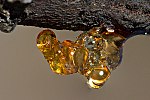Anexudateis a fluid released by anorganismthrough pores or a wound, a process known asexudingorexudation.[1] Exudateis derived fromexude'to ooze'[2]fromLatinexsūdāre'to (ooze out) sweat' (ex-'out' andsūdāre'to sweat').[3]
Medicine
editAn exudate is anyfluidthat filters from thecirculatory systemintolesionsor areas ofinflammation.It can be a pus-like or clear fluid. When an injury occurs, leaving skin exposed, it leaks out of the blood vessels and into nearby tissues. The fluid is composed ofserum,fibrin,andleukocytes.Exudate may ooze from cuts or from areas of infection or inflammation.[4]
Types
edit| Transudatevs.exudate | ||
|---|---|---|
| Transudate | Exudate | |
| Main causes | ↑hydrostatic pressure, ↓colloid osmotic pressure |
Inflammation,increased vascular permeability |
| Appearance | Clear[5] | Cloudy[5] |
| Specific gravity | <1.012 | >1.020 |
| Proteincontent | < 2.5 g/dL | > 2.9 g/dL[6] |
| fluid [protein] serum [protein] |
< 0.5 | > 0.5[7] |
| SAAG= serum [albumin] − fluid [albumin] |
> 1.2 g/dL | < 1.2 g/dL[8] |
| fluidLDH upper limit for serum |
< 0.6 or <2⁄3 | > 0.6[6]or >2⁄3[7] |
| Cholesterolcontent | < 45 mg/dL | > 45 mg/dL |
| RadiodensityonCT scan | 2 to 15HU[9] | 4 to 33HU[9] |
- Purulent or suppurative exudate consists of plasma with both active and deadneutrophils,fibrinogen,andnecroticparenchymal cells.This kind of exudate is consistent with more severe infections, and is commonly referred to aspus.
- Fibrinous exudate is composed mainly offibrinogenandfibrin.It is characteristic ofrheumatic carditis,but is seen in all severe injuries such asstrep throatandbacterial pneumonia.Fibrinous inflammation is often difficult to resolve due to blood vessels growing into the exudate and filling space that was occupied by fibrin. Often, large amounts of antibiotics are necessary for resolution.
- Catarrhal exudateis seen in the nose and throat and is characterized by a high content of mucus.
- Serous exudate (sometimes classified as seroustransudate) is usually seen in mild inflammation, with relatively low protein.[10]Its consistency resembles that of serum, and can usually be seen in certain disease states liketuberculosis.(See below for difference between transudate and exudate)
- Malignant (or cancerous) pleural effusion is effusion wherecancer cellsare present.[11]It is usually classified as exudate.
Types of exudates: serous, serosanguineous, sanguineous, hemorrhaging and purulent drainage.
- Serous: Clear straw colored liquid that drains from the wound. This is a normal part of the healing process.
- Serosanguineous: Small amount of blood is present in the drainage; it is pink in color due to the presence of red blood cells mixed with serous drainage. This is a normal part of the healing process.
- Sanguineous: This type of drainage contains red blood due to trauma of blood vessels, this may occur while cleaning the wound. Sanguineous drainage is abnormal.
- Hemorrhaging: This type of drainage contains frank blood from a leaking blood vessel. This will require emergency treatment to control the bleed. This type of drainage is abnormal.
- Purulent drainage: This type of drainage is malodorous and can be yellow, gray, or greenish in color. This is an indication of an infection.
Exudates vs. transudates
editThere is an important distinction betweentransudatesand exudates. Transudates are caused by disturbances ofhydrostaticorcolloid osmotic pressure,not by inflammation. They have a low protein content in comparison to exudates. Medical distinction between transudates and exudates is through the measurement of thespecific gravityof extracted fluid. Specific gravity is used to measure the protein content of the fluid. The higher the specific gravity, the greater the likelihood ofcapillarypermeabilitychanges in relation tobody cavities.For example, the specific gravity of the transudate is usually less than 1.012 and a protein content of less than 2 g/100 mL (2 g%).Rivalta testmay be used to differentiate an exudate from a transudate. It is not clear if there is a distinction in the difference of transudates and exudates in plants.
Plant exudates
editPlant exudates includesaps,gums,latex,andresin.Sometimesnectaris considered an exudate.[12]Plant seeds exudate a variety of molecules into thespermosphere,[13]androots exudateinto therhizosphere;these exudates include acids, sugars,polysaccharidesandectoenzymes,and collectively account for 40% of root carbon.[14]Exudation of these compounds has various benefits to the plant and to themicroorganismsof the rhizosphere.[15][16]
See also
editReferences
edit- ^"exudate".The Free Dictionary - Medical.Retrieved5 August2014.
- ^""Exude" Merriam-Webster Online Dictionary ".Merriam Webster.2008.Retrieved2008-07-04.
- ^Robert K. Barnhart, ed. (1988).Chambers Dictionary of Etymology.New York: Chambers Harrap Publishers. p. 363.ISBN0-550-14230-4.
- ^"Exudate".MedlinePlus.
- ^abThe University of Utah • Spencer S. Eccles Health Sciences Library > WebPath images >"Inflammation".
- ^abHeffner J, Brown L, Barbieri C (1997). "Diagnostic value of tests that discriminate between exudative and transudative pleural effusions. Primary Study Investigators".Chest.111(4):970–80.doi:10.1378/chest.111.4.970.PMID9106577.
- ^abLight R, Macgregor M, Luchsinger P, Ball W (1972). "Pleural effusions: the diagnostic separation of transudates and exudates".Ann Intern Med.77(4):507–13.doi:10.7326/0003-4819-77-4-507.PMID4642731.
- ^Roth BJ, O'Meara TF, Gragun WH (1990). "The serum-effusion albumin gradient in the evaluation of pleural effusions".Chest.98(3):546–9.doi:10.1378/chest.98.3.546.PMID2152757.
- ^abCullu, Nesat; Kalemci, Serdar; Karakas, Omer; Eser, Irfan; Yalcin, Funda; Boyaci, Fatma Nurefsan; Karakas, Ekrem (2013)."Efficacy of CT in diagnosis of transudates and exudates in patients with pleural effusion".Diagnostic and Interventional Radiology.20:116–20.doi:10.5152/dir.2013.13066.ISSN1305-3825.PMC4463296.PMID24100060.
- ^Robbins Basic Pathology 7th ed
- ^About.com > Malignant Pleural EffusionArchived2012-02-26 at theWayback MachineBy Lynne Eldridge MD. Updated March 27, 2010
- ^Power, Michael L. (2010). Anne M. Burrows; Leanne T. Nash (eds.).The Evolution of Exudativory in Primates / Nutritional and Digestive Challenges to Being a Gum-feeding Primate.Springer. p. 28.ISBN9781441966612.Retrieved2 October2012.
- ^Schiltz, S; Gaillard, I; Pawlicki-Jullian, N; Thiombiano, B; Mesnard, F; Gontier, E (December 2015). "A review: what is the spermosphere and how can it be studied?".Journal of Applied Microbiology.119(6):1467–81.doi:10.1111/jam.12946.PMID26332271.S2CID42515027.
- ^Marschner, Horst (1995).Mineral Nutrition of Higher Plants.ISBN0124735436.
- ^Walker, T. S.; Bais, H. P.; Grotewold, E.; Vivanco, J. M. (2003)."Root Exudation and Rhizosphere Biology".Plant Physiology.132(1):44–51.doi:10.1104/pp.102.019661.PMC1540314.PMID12746510.
- ^Martins, S. J.; Medeiros, F. H. V.; Lakshmanan, V.; Bais, H. P. (2018)."Impact of Seed Exudates on Growth and Biofilm Formation of Bacillus amyloliquefaciens ALB629 in Common Bean".Frontiers in Microbiology.8:2631.doi:10.3389/fmicb.2017.02631.PMC5767182.PMID29375501.
External links
edit- Media related toExudateat Wikimedia Commons

